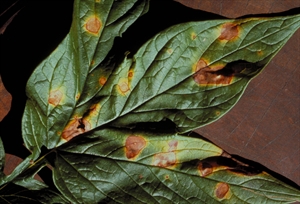Arrowroot leaf spot
Pacific Pests, Pathogens, Weeds & Pesticides - Online edition
Pacific Pests, Pathogens, Weeds & Pesticides
Arrowroot leaf spot (222)
Cercospora taccae
Oceana, and also reported from the Philippines. It is recorded from American Samoa, Cook Islands, Fiji, Kiribati, Marshall Islands, New Caledonia, Niue, Papua New Guinea, Palau, Samoa, Tonga, and Tuvalu.
Polynesian arrowroot.
The fungus produces spots on mature leaves; these are round to irregular, grey-brown, surrounded by a bright yellow halo (Photos 1&2). The spots often merge and cause a yellowing and drying of the leaves.
The disease is typically one of wet weather. Spores, which are produced in large numbers on the undersides of the leaves, are spread in wind and rain. Survival is in the remains of leaves, and by plants of different ages being grown together so that there are always leaves for spores to infect.
Little research has been done on this disease, and yield losses are not reported. Under conditions which suit the fungus, especially high rainfall, damage is likely to be severe, and consequently tuber development may be affected.
Look for the large, round, brown spots with yellow haloes on the mature leaves.
CULTURAL CONTROL
Control of this disease is difficult because of the traditional method of cultivation of the crop. Arrowroot plants are often harvested when there is need, rather than all at once. Smaller tubers are then left to grow in place. This means that arrowroot patches contain plants of all ages, so spores easily move from old to young plants.
During growth:
- Remove infected leaves when the disease is first seen, and burn them; this would only apply to newly planted patches of the same age.
After harvest:
- Collect the remains of the crop and destroy by burning or burying.
- Practise crop rotation; this might not be possible because of the traditional way of growing the crop,
- Replant patches all at one time in a new site, using tubers; this is a practical method of breaking the disease cycle, and could be useful if the disease is severe.
CHEMICAL CONTROL
It is unlikely that fungicides would be economic, unless arrowroot was grown for starch production; if a fungicide was required, mancozeb would be suitable (see Fact Sheet no. 002). Fungicides are only recommended for commercial plantations; examples are:
(i) Protectant fungicides (these stay on the surface of plants) -
- Mancozeb.
- Copper hydroxide.
- Chlorothalonil.
- Banana misting oil.
Mancozeb can be used together with oil or an oil/water emulsion; chlorothalonil is used in water.
(ii) Systemic fungicides (these move inside the plants) -
- Triazoles (e.g, propiconazole, fenbuconazole and tebunconazole).
- Strobilurins (e.g., azoxystrobin).
It is important to rotate the fungicides in the different groups to prevent the build up of resistant strains of the fungus. No more than two applications of the same systemic fungicide should be made before changing to another group. In drier times, mancozeb can be used alone. Note, it is important to add a sticker to any of the fungicides.
____________________
When using a pesticide, always wear protective clothing and follow the instructions on the product label, such as dosage, timing of application, and pre-harvest interval. Recommendations will vary with the crop and system of cultivation. Expert advice on the most appropriate pesticides to use should always be sought from local agricultural authorities.
AUTHOR Grahame Jackson
Information from Wright JG et al. (2005) Weeds and plant pathogenic fungi and viruses in Tokelau. SPC Land Resources Division, Suva, Fiji. (https://www.google.com/search?q=arrowroot+leaf+spot&oq=arrowroot+leaf+spot&aqs=chrome..69i57j33i160.13586j0j4&sourceid=chrome&ie=UTF-8; and from Phengsintham P et al. (2014) Monograph of Cercosporoid fungi from Laos. current Research in Environment & Applied Mycology. (https://www.creamjournal.org/pdf/Cream_3_1_2.pdf). Photos 1&2 Kohler F, et al. (1997) Diseases of cultivated crops in Pacific Island countries. South Pacific Commission. Pirie Printers Pty Limited, Canberra, Australia.
Produced with support from the Australian Centre for International Agricultural Research under project PC/2010/090: Strengthening integrated crop management research in the Pacific Islands in support of sustainable intensification of high-value crop production, implemented by the University of Queensland and the Secretariat of the Pacific Community.





